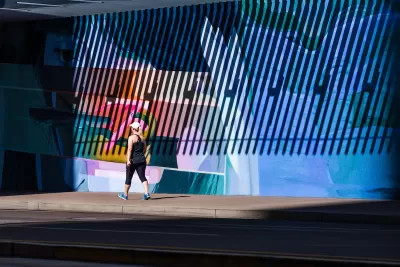Coatings that reflect heat can make the air feel warmer for people standing on and around these surfaces.

New research from Arizona State University delves into the complicated impacts of cool pavement treatments, which can reduce surface temperatures in concrete-heavy urban areas but can also increase the “thermal stress” felt by a person standing on these heat-reflective surfaces and are thus not appropriate for all areas.
Writing in Smart Cities Dive, Ysabelle Kempe explains, “Cool pavement technology is most effective on large parking lots that lack shade or in car-centric cities with hot climates, low cloud cover and wide residential streets, the researchers say. It’s not effective in high-rise downtown areas and shouldn’t be used in areas with high pedestrian traffic like playgrounds, plazas or parks, they add.”
In essence, the treatments have a bigger effect on the surface they’re applied to than on the ambient temperature for people walking on them. “Experts say these types of results indicate cool pavement is not a solution to rising heat-related illness and death tolls. Indeed, the researchers in Phoenix say that installing cool pavement in areas with high pedestrian traffic could be considered a ‘maladaptation’ in regards to the experience of pedestrians,” inadvertently putting people at higher risk for heat-related illnesses.
The study suggests that cities’ heat mitigation strategies should focus more on trees and other ways to create shade.
FULL STORY: Phoenix cool pavement study shows technology tradeoffs

Alabama: Trump Terminates Settlements for Black Communities Harmed By Raw Sewage
Trump deemed the landmark civil rights agreement “illegal DEI and environmental justice policy.”

Study: Maui’s Plan to Convert Vacation Rentals to Long-Term Housing Could Cause Nearly $1 Billion Economic Loss
The plan would reduce visitor accommodation by 25% resulting in 1,900 jobs lost.

Planetizen Federal Action Tracker
A weekly monitor of how Trump’s orders and actions are impacting planners and planning in America.

Wind Energy on the Rise Despite Federal Policy Reversal
The Trump administration is revoking federal support for renewable energy, but demand for new projects continues unabated.

Passengers Flock to Caltrain After Electrification
The new electric trains are running faster and more reliably, leading to strong ridership growth on the Bay Area rail system.

Texas Churches Rally Behind ‘Yes in God’s Back Yard’ Legislation
Religious leaders want the state to reduce zoning regulations to streamline leasing church-owned land to housing developers.
Urban Design for Planners 1: Software Tools
This six-course series explores essential urban design concepts using open source software and equips planners with the tools they need to participate fully in the urban design process.
Planning for Universal Design
Learn the tools for implementing Universal Design in planning regulations.
Caltrans
Smith Gee Studio
Institute for Housing and Urban Development Studies (IHS)
City of Grandview
Harvard GSD Executive Education
Toledo-Lucas County Plan Commissions
Salt Lake City
NYU Wagner Graduate School of Public Service





























